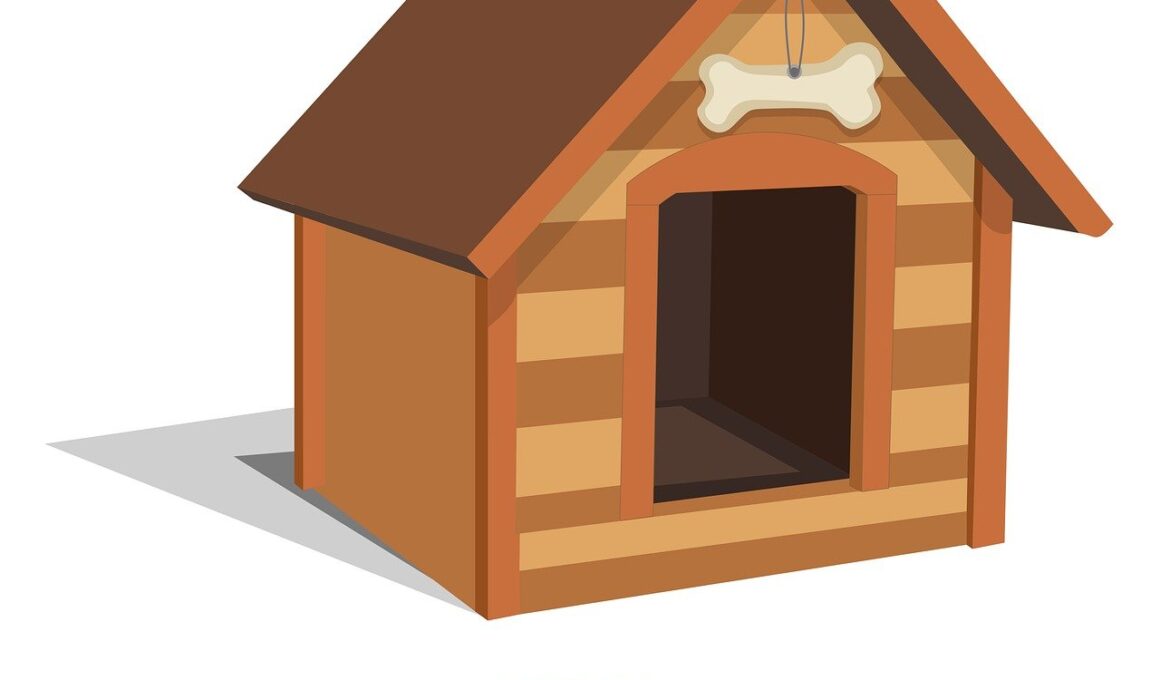Using Reflective Materials to Enhance Insulation in Dog Houses
When selecting an insulated dog house, using reflective materials can drastically improve the thermal efficiency of the space. These materials create a barrier that reflects heat away during summer months while retaining warmth in the winter. Insulation products like radiant barriers, commonly used in residential homes, can be equally effective in dog houses. A well-insulated dog house protects dogs from extreme temperatures, ensuring they stay healthy and comfortable year-round. Additionally, specific reflective materials, such as Mylar, focus on directing heat back into the sleeping area, optimizing warmth during the cold months. Combining these products with traditional insulating foam or fiberglass can create an even more effective insulative structure. Therefore, pet owners seeking to maintain a comfortable environment for their dogs should consider upgrading insulation strategies. Utilizing reflective materials might also lead to energy-efficient solutions, reducing overall heating costs. To create a cozy haven for your pet, explore various options in materials and insulation. An informed choice will serve not just the dog’s comfort, but also their health. Overall, dog houses should be designed with the utmost care to prevent adverse weather impacts.
Construction design plays a vital role in the effectiveness of insulated dog houses. A well-thought-out design considers not only insulation materials but also how air circulation affects temperature retention. For example, elevated dog houses allow for better airflow beneath, which minimizes moisture buildup and dampness within the structure. To further enhance this effect, reflective materials should line the interior walls, creating a barrier against escaping heat. Adequate ventilation holds significance, mainly because excess moisture leads to mold and mildew, which can harm a dog’s health. Using reflective roofing materials can also reduce heat absorption while maintaining cooler internal temperatures on hot days. Furthermore, an insulated dog house must have appropriately sized entrances to maintain warmth. Entrances that are too open allow cold drafts to seep in, while those that are too snug may hinder easy access for your dog. Consider using flaps or doors made from heavier materials to block drafts. Aesthetic elements may also enhance these practical features, blending functionality with pleasing appearances. The goal should be creating a safe and comfortable environment for the dog inside for immediate relief from weather extremes.
Benefits of Reflective Insulation
Reflective insulation offers numerous benefits for canine dwellings, especially those exposed to varying climates. One of its primary advantages is its ability to regulate internal temperatures, creating a consistent environment. Dogs, like humans, can suffer from heat stress or exposure to cold, making it essential to provide shelter that transforms seasonal conditions into a haven. Through the implementation of reflective materials, the need for external heating and cooling mechanisms diminishes, aligning better with eco-friendly practices. Moreover, these materials can also contribute to moisture control, significantly reducing the chances of mold developing inside the dog house. Utilizing layered insulation, with reflections coupled with thick insulating foam, improves thermal resistance overall. Not only does this aid in comfort for your pet, but it also extends the life of the dog house itself under rigorous weather conditions. Reduced energy costs and less reliance on external heating sources form part of the sustainability equation. Further, such advanced insulation encourages dogs to use their houses all year round, enhancing emotional security as they seek refuge from the elements. Investing in reflective insulation is a step towards better dog care.
Choosing the right tools and materials is crucial when incorporating reflective materials into a dog house. DIY enthusiasts can find various options at hardware stores or online. Essential tools may include utility knives, measuring tapes, and heavy-duty adhesives. Reflective materials such as radiant barrier foil can be effectively cut to fit custom dog house dimensions. Furthermore, adhesive options tailored for outdoor use can ensure durability against inclement weather. During installation, it’s advisable to layer reflective materials with traditional insulation products for maximum results. Proper sealing of edges prevents air and moisture intrusion, securing the integrity of insulation. Additionally, insulation sheets may be lined with waterproof coverings to provide further protection. Choosing colors for the external appearance might also impact thermal efficiency; lighter colors tend to reflect more sunlight while darker shades absorb. Ensuring a snug fit of insulation panels is vital, as gaps can significantly reduce effectiveness. For a successful installation, consider consulting tutorials available through community resources or instructional websites. Engaging local expert opinions may provide invaluable insights. Even participating in online forums can connect you with experienced enthusiasts in the field.”},{
Considerations for Climate Conditions
When designing an insulated dog house, evaluating local climate conditions is essential. Regions with harsh winters require robust insulation strategies to keep dogs warm, while hotter areas demand heat-reflective surfaces to maintain cool interiors. For extreme climates, using thicker insulating layers proves advantageous, often including both foam insulation for warmth and reflective materials to manage heat. Local weather data can guide pet owners in choosing the best materials for insulation and construction. Furthermore, studying common weather patterns—like rainfall or snow amounts—will help in planning effective drainage and ventilation systems. Through proper air circulation, moisture issues can be minimized, protecting the family pet from health risks like hypothermia or heatstroke. Additionally, installing removable insulating panels may allow for adaptability to changes in seasons. Foreseeing future climate changes could also impact decision-making; reflectivity may become more important if temperatures rise consistently in the coming years. Moreover, the surrounding environment—such as the presence of trees or buildings—can influence temperature within the dog house. All of these factors contribute to designing a thoughtful shelter, ensuring dogs remain happy and safe throughout their lives.
Aside from temperature control, the longevity of reflective insulation materials impacts dog house maintenance. Selecting high-quality reflective components ensures durable performance even during extreme weather conditions. Various brands offer different durability ratings, so checking those is crucial before a purchase. A common misconception is that reflective materials are only beneficial for short-term use; however, with proper installation, they can last for many years. When weatherproofing dog houses, it’s vital to choose reflective sheeting that resists discoloration and deterioration. Quality assurance may also factor into brand choices, fostering confidence in claiming product lifespan. Additionally, incorporating air barriers might limit moisture intrusion, thus preserving insulation integrity over time. Regular inspections of dog houses should be a part of proactive maintenance routines, effectively identifying and addressing potential issues before they escalate. Attention to small wear and tear can save on costly repairs down the line. Lastly, remember to follow manufacturer guidelines for cleaning intrusive materials, as improper care may affect reflectivity. In conclusion, thoughtful choices during the insulation process contribute to both immediate comfort and long-term savings.
Conclusion: Achieving Optimal Insulation
To conclude, employing reflective materials in insulated dog houses provides significant benefits for pets and their owners alike. This innovative approach leads to improved temperature regulation and energy savings while offering necessary protection from harsh weather conditions. Understanding reflective principles and combining them effectively with traditional insulation methods caters to a dog’s entire seasonal comfort needs. Careful consideration of material selections, construction design, and climate adaptability ensures that insulated dog houses can withstand the test of time. Engaging in ongoing maintenance practices creates longevity while fostering a sense of security for the furry inhabitants. Moreover, pet owners can experience peace of mind knowing that their dogs enjoy an enhanced quality of life. Ultimately, the initial investment in quality reflective insulation pays off in both comfort and energy savings. This commitment reflects a responsible choice, advocating for animal welfare and sustainability. Dogs being cared for in this considered manner are more likely to thrive under supportive conditions. Emphasizing proper insulative strategies not only protects pets but also enhances the emotional bond between owner and dog. By prioritizing insulation, every pet owner ensures their cherished companions stay protected and happy.
Taking all these factors into account leads to a strategic approach when deciding upon dog house insulation, fulfilling both needs and expectations. The exceptional capabilities of reflective materials present an opportunity to contribute to a dog’s well-being. Every aspect—from construction designs to climate influence—paves the path for creating comfortable housing solutions. Additionally, reflecting on best practices within the dog care community can yield tremendous insights, supporting a network of informed owners. Resources such as pet care blogs, community forums, and expert reviews provide valuable information to enhance decision-making skills. By following guidelines and recommendations, owners can maximize the benefits of reflective insulation. Ultimately, investing in durable, high-quality materials creates lasting comfort and safety for dogs residing in extreme climate zones. Prioritizing pet welfare goes hand-in-hand with sustainable living efforts. One thing is clear: a well-insulated dog house represents more than just shelter; it embodies a commitment to a better quality of life for furry companions. The time to take action is now, ensuring that every dog has a warm, safe, and inviting space to call home.


